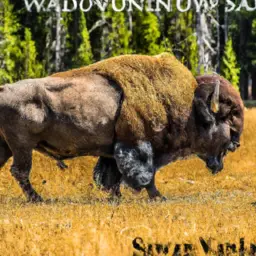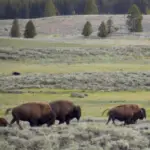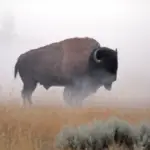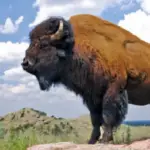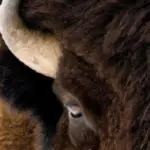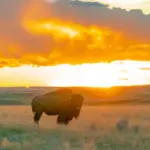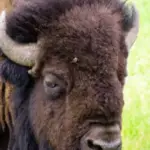Are you planning a trip to Yellowstone National Park and want to witness the remarkable phenomenon of the bison rut? Look no further! Get all the information you need about the bison rutting season in Yellowstone with our product, “When Is The Bison Rut In Yellowstone.” This comprehensive guide will provide you with the exact dates and locations where you can observe this awe-inspiring event, ensuring an unforgettable experience in the stunning wilderness of Yellowstone. Don’t miss out on this unforgettable natural spectacle – get your copy of “When Is The Bison Rut In Yellowstone” today!
Understanding the Bison Rut
The bison rut, also known as the breeding season, is a fascinating natural phenomenon that occurs in Yellowstone National Park. During this time, male bison compete for dominance and the opportunity to mate with females. Understanding the bison rut involves delving into the behaviors exhibited during this period and exploring the reasons behind its occurrence.
Definition of a Rut
In the context of bison, a rut refers to a period when male bison experience heightened aggression and compete with each other for the attention of female bison. This intense behavioral change is characterized by male bison bellowing, wallowing, and engaging in physical displays of dominance. The bison rut is a critical part of their reproductive cycle and plays a significant role in maintaining the population of these magnificent creatures.
Behavior during Bison Rut
During the bison rut, male bison engage in various behaviors to establish and defend their dominance. These behaviors include head butting, horn wrestling, and snorting. They also emit deep, rumbling bellows to attract the attention of female bison and to assert their dominance over rivals. Additionally, male bison engage in wallowing, which involves rolling in mud or dust to mark their territory and enhance their scent.
Why Bison Rut Occurs
The primary purpose of the bison rut is to ensure successful reproduction within the bison population. By competing for mates, dominant male bison have the opportunity to mate with multiple females, thus increasing the chances of producing offspring. The bison rut is a result of biological cues, such as hormonal changes, that trigger these reproductive behaviors. The evolutionary benefits of the bison rut lie in ensuring genetic diversity and the survival of the species.
Timing of the Bison Rut in Yellowstone
Understanding the timing of the bison rut in Yellowstone is essential for both researchers and visitors. The rhythms of nature dictate the timeline of this captivating phenomenon, which follows a relatively consistent pattern.
Typical Rut Timeline
The bison rut in Yellowstone typically occurs between late July and early September. This duration allows for optimal conditions for mating and calf birth in the following spring. The exact timing of the rut can vary slightly from year to year, influenced by environmental factors and individual bison’s physiology.
Factors affecting Timing of Rut
Several factors influence the timing of the bison rut in Yellowstone. One crucial factor is the availability of resources, such as favorable grazing conditions and water sources. If these resources are abundant, it enables the bison to invest energy into the rutting season. Additionally, weather patterns and changes in daylight hours play a role in triggering hormonal changes that influence rut initiation.
Fluctuations in Rut Dates Over Years
While the bison rut generally occurs within the late summer months, there can be slight variations in the dates from year to year. Factors such as weather fluctuations, changes in resource availability, and individual variations in bison physiology can impact the precise timing of the rut. Studying and understanding these fluctuations can provide valuable insights into the interconnectedness between bison behavior and their surrounding environment.
The Role of the Weather and Climate
The weather and climate in Yellowstone play a crucial role in shaping the bison rut and its timing. Understanding the impact of seasonal changes and climate patterns provides valuable insights into this complex natural phenomenon.
Impact of Seasonal Changes on Rut
Seasonal changes, such as the transition from spring to summer, influence the bison rut. As the weather warms and food becomes more plentiful, male bison experience increased energy levels, triggering their engagement in rutting behaviors. The availability of food resources and favorable weather conditions also contribute to the overall success of the bison rut.
Correlation between Weather Patterns and Timing of Rut
Weather patterns, including temperature, precipitation, and daylight hours, influence the hormonal changes that initiate the bison rut. A colder spring, for example, may delay the onset of the rut as resources may be limited. Conversely, a warmer summer may expedite the rut due to increased food availability and enhanced energy levels in male bison. These intricate weather correlations highlight the complex interplay between the bison rut and climatic conditions.
The Relationship with Climate Change
Climate change has the potential to impact the bison rut in Yellowstone. As temperatures rise and weather patterns become more unpredictable, it can disrupt the delicate balance of resources and alter hormonal cues in bison. Changes in vegetation growth, water availability, and shifts in climate patterns can all have cascading effects on the timing and success of the bison rut. Studying these relationships is crucial for understanding and mitigating the potential impacts of climate change on Yellowstone’s bison population.
Physical and Behavioral Changes in Bison During Rut
The bison rut brings about significant physical and behavioral changes in male and female bison. These changes are crucial for reproductive success and play a pivotal role in the overall dynamics of the rut.
Changes in Male Bison
Male bison undergo notable physical and behavioral changes during the rut. Their testosterone levels surge, leading to increased aggression and dominance displays. The most apparent physical change is the development of a thick, muscular hump on the males’ shoulders, which further enhances their dominance and intimidating appearance. Male bison also become more vocal, emitting deep bellows to attract the attention of females and assert their dominance over rivals.
Impacts on Female Bison
While the physical changes in female bison during the rut are less pronounced, their behavior undergoes shifts as well. Female bison become more receptive to mating attempts from dominant males and become more selective in choosing their mates. They display specific behaviors, such as head tossing and tail raising, to indicate their receptivity to male advances. These behavioral changes increase the chances of reproductive success and contribute to the overall success of the bison rut.
Observing Behavior Shifts
Witnessing the physical and behavioral changes that occur during the bison rut is an incredible experience for visitors to Yellowstone. Proper observation from a safe distance allows visitors to gain insight into the complex dynamics of the rut and appreciate the natural beauty and power of these remarkable animals.
Challenges Bison Face During the Rut
The bison rut is not without its challenges, both for the bison themselves and for their overall population. Understanding these challenges is essential for effective conservation efforts and maintaining the well-being of the bison population in Yellowstone.
Territorial Disputes
Territorial disputes during the rut can result in fierce battles between male bison. Fighting for dominance and the opportunity to mate can lead to injuries and even death. These territorial disputes are part of the natural selection process, where only the strongest individuals pass on their genes to the next generation.
Health Implications
The intense physical exertion and aggression displayed during the rut can take a toll on the individual health of male bison. The risk of injuries, exhaustion, and even malnutrition increases during this period. Additionally, the risks associated with transmitting diseases or parasites also rise due to increased physical contact between individuals.
Increased Vulnerability to Predation
Male bison, preoccupied with rutting behaviors and maintaining dominance, become more vulnerable to predation during this time. The distraction and exhaustion that come with the rut can make them easier targets for predators, such as wolves or bears. This vulnerability highlights the delicate balance between the benefits of the rut and the risks faced by individual bison.
Implications for the Bison Population in Yellowstone
The bison rut in Yellowstone has far-reaching implications for the overall bison population and the ecological health of the park. Understanding these implications helps guide management strategies and conservation efforts.
Impact on Birth Rates
The bison rut is a crucial factor in determining birth rates within the population. Successful mating during the rut leads to a high percentage of females becoming pregnant, increasing the chances of successful reproduction and the subsequent growth of the population. Monitoring birth rates and their relationship to the bison rut provides valuable information for assessing the health and stability of the population.
Effect on Bison Migration Patterns
The bison rut can also influence migration patterns within the Yellowstone ecosystem. As resources shift with the changing seasons, bison may alter their movement to meet their needs during the rut. The availability of mating opportunities and territorial boundaries may impact the timing and direction of migration routes. Understanding these patterns is crucial for preserving the natural behaviors and movements of the bison population.
Ecological Role of the Bison Rut
The bison rut plays a vital ecological role within Yellowstone. By challenging and reshaping the landscape through their behaviors, such as wallowing and grazing, bison contribute to the overall health and diversity of plant communities. Their movements and territory establishment can also influence the distribution of other wildlife species, creating a complex web of ecological interactions.
Interaction with Other Animals During Rut
The bison rut not only affects the behavior and dynamics of the bison themselves but also has implications for the interactions between bison and other animal species within the park.
Interaction with Other Bison
The bison rut brings heightened social interactions among individuals of the same species. While male bison engage in aggressive behavior towards each other to establish dominance, they also form temporary alliances and social bonds. Female bison, on the other hand, experience increased attention and courtship displays from male bison. These intricate social dynamics among bison shape their overall behavior and contribute to the success of reproduction within the population.
Cross-species Interactions
The bison rut also has implications for the interactions between bison and other wildlife species in Yellowstone. The increased movement and territorial behaviors of bison can affect the behavior and movements of other grazers, such as elk or pronghorn, creating shifts in their foraging patterns and resource utilization. Additionally, the heightened scent marking and activity can influence the behavior of predators, such as wolves or bears, who may exploit the vulnerability of male bison during this time.
Effects on Yellowstone’s Ecosystem
The bison rut, along with its associated interactions, contributes to the overall ecological health and diversity of Yellowstone’s ecosystem. The physical changes in the landscape caused by bison behaviors, such as wallowing and grazing, create habitat diversity and facilitate the growth of specific plant species. The interconnectedness between bison and other species helps maintain a balanced ecosystem, where each organism plays a vital role in shaping the natural processes and maintaining biodiversity.
Safety and Guidelines for Visitors During Bison Rut
Observing the bison rut can be an awe-inspiring experience, but visitors must prioritize safety and follow guidelines to protect both themselves and the bison.
Park Rules during Rut
It is crucial for visitors to familiarize themselves with the park rules and regulations concerning wildlife viewing and safety. Maintaining a safe distance from the bison, refraining from approaching or feeding them, and remaining within designated viewing areas are some of the essential guidelines to follow during the rut. Parks rangers and informational signage provide invaluable guidance and ensure a safe experience for all.
Tips for Safe Observation of Bison Rut
To safely observe the bison rut, visitors should keep a safe distance of at least 25 yards from the bison. Using binoculars or spotting scopes allows for closer observation while maintaining a respectful distance. Being aware of personal surroundings, such as the presence of other animals or potential hazards, ensures a safe and enjoyable experience for all visitors.
Potential Risks and How to Avoid Them
Visitors must be aware of the potential risks associated with the bison rut and take appropriate precautions. Male bison can be unpredictable and may charge if they perceive a threat. It is crucial to remain calm, avoid sudden movements, and find cover behind a large object, such as a vehicle or tree, if charged. By following safety guidelines and respecting the bison’s natural behavior, visitors can observe the rut while ensuring the well-being of both themselves and the bison.
Scientific Studies on Bison Rut in Yellowstone
Scientific research plays a vital role in enhancing our understanding of the bison rut and its ecological significance in Yellowstone. Past studies, ongoing research, and future opportunities provide valuable insights into this awe-inspiring phenomenon.
Past Research
Past studies on the bison rut in Yellowstone have contributed significantly to our understanding of bison behavior, reproductive biology, and ecological implications. These studies have utilized various research methods, including behavioral observations, hormone analysis, and genetic studies, to unravel the intricacies of the rut. By building upon these foundations, researchers have gained invaluable knowledge about bison and their role within the ecosystem.
Ongoing Studies
Ongoing studies on the bison rut continue to shed light on new aspects of this complex phenomenon. Researchers are using advanced technologies, such as GPS tracking, to understand the movement patterns of bison during the rut and its underlying environmental factors. Additionally, ongoing studies are investigating how climate change and human activities influence the bison rut and its implications for the overall population and ecosystem.
Future Research Opportunities
There are still numerous research opportunities regarding the bison rut in Yellowstone. Further studies can focus on exploring the long-term impacts of climate change on the timing and behavior of the rut. Investigating the genetic diversity and reproductive success in relation to the rut can provide valuable insights into the overall health and resilience of the bison population. Continued research efforts aim to deepen our understanding of this spectacular natural phenomenon and guide effective conservation strategies.
Is the Bison Rut a Factor in the Population of Bison in Yellowstone?
The bison rut does not significantly impact the number of bison in Yellowstone. While these intense mating behaviors can lead to injuries or even deaths, they do not have a substantial effect on overall population numbers. Factors like habitat availability and human interference have a much larger impact.
Impact of Human Activity on Bison Rut
Human activity in Yellowstone can have varying impacts on the bison rut, ranging from potential disruptions to conservation opportunities. It is crucial to consider these effects to promote responsible interaction and ensure the long-term well-being of the bison population.
Effects of Tourism
Tourism in Yellowstone can exert both positive and negative influences on the bison rut. Responsible tourism practices, such as following park guidelines and maintaining a safe distance, minimize disruptions to the natural behaviors of bison during the rut. However, unregulated or unethical tourism practices can lead to stress, behavioral changes, and altered movement patterns among the bison population. Balancing access to the rut for visitors with the conservation needs of the bison is a constant challenge for park management.
Influence of Park Management Practices
Park management practices play a crucial role in preserving the integrity of the bison rut and mitigating potential impacts. Strategies such as habitat conservation, vegetation management, and observing visitor guidelines contribute to maintaining suitable conditions for the rut. By understanding the ecological requirements of bison, park managers can implement practices that preserve the natural rhythms and behaviors of the rut while considering the safety and enjoyment of visitors.
Impact of Climate Change
Climate change poses challenges to the bison rut in Yellowstone. Rising temperatures, altered precipitation patterns, and changes in vegetation growth can disrupt the delicate balance of resources and potentially impact the timing and success of the rut. Conservation efforts focusing on mitigating the effects of climate change and ensuring the resilience of the bison population become increasingly crucial. By understanding these impacts, researchers, park managers, and visitors can collectively work towards minimizing the adverse effects of climate change on the bison rut.
In conclusion, understanding the bison rut in Yellowstone is a multifaceted endeavor that combines behavioral observations, ecological research, and an appreciation for the interconnectedness of all living organisms within the park. By understanding the definition, behavior, timing, and ecological implications of the bison rut, we can foster responsible interaction and conservation practices that ensure the long-term success of this awe-inspiring natural phenomenon.

